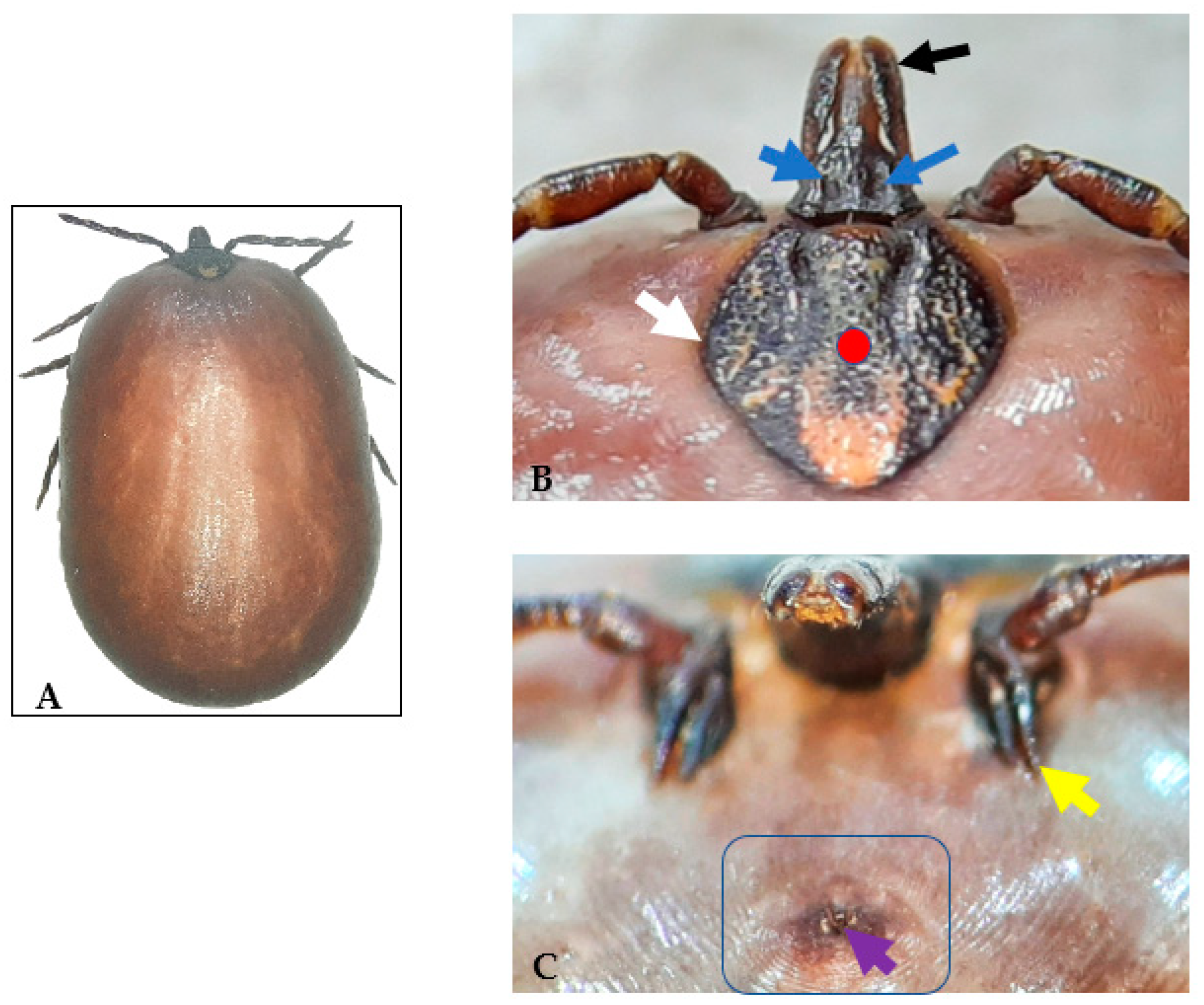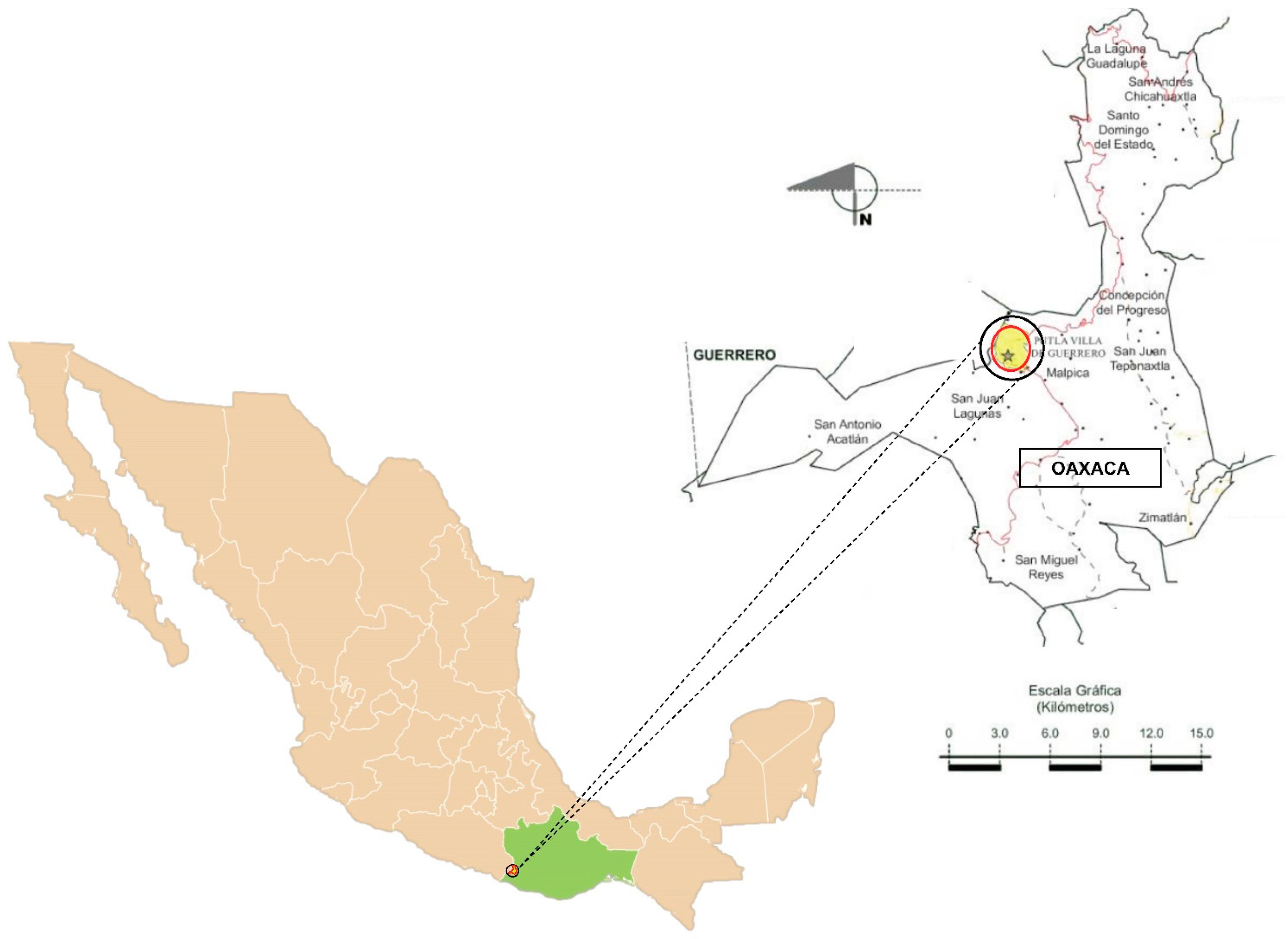Identification of Amblyomma ovale Koch, 1844 (Acari: Ixodidae) in a Bloodhound Dog from Oaxaca, Mexico
Abstract
1. Introduction
2. Results and Discussion
3. Materials and Methods
4. Conclusions
Author Contributions
Funding
Institutional Review Board Statement
Informed Consent Statement
Data Availability Statement
Acknowledgments
Conflicts of Interest
References
- Guglielmone, A.A.; Robbins, R.G.; Apanaskevich, D.A.; Petney, T.N.; Estrada-Peña, A.; Horak, I.G. The Hard Ticks of the World; Springer: Dordrecht, The Netherlands, 2014; p. 738. [Google Scholar]
- Volzit, O.V. A review of Neotropical Amblyomma species (Acari: Ixodidae). Acarina 2007, 15, 3–134. [Google Scholar]
- Martins, T.F.; Onofrio, V.C.; Barros-Battesti, D.M.; Labruna, M.B. Nymphs of the genus Amblyomma (Acari: Ixodidae) of Brazil: Descriptions, redescriptions, and identification key. Ticks Tick Borne Dis. 2010, 1, 75–99. [Google Scholar] [CrossRef] [PubMed]
- Lippi, C.A.; Gaff, H.D.; White, A.L.; Ryan, S.J. Scoping review of distribution models for selected Amblyomma ticks and rickettsial group pathogens. Peer J. 2021, 9, e10596. [Google Scholar] [CrossRef] [PubMed]
- Guzmán-Cornejo, C.; Robbins, R.G.; Guglielmone, A.A.; Montiel-Parra, G.; Pérez, T.M. The Amblyomma (Acari: Ixodida: Ixodidae) of Mexico: Identification keys, distribution and hosts. Zootaxa 2011, 2998, 16–38. [Google Scholar]
- Guglielmone, A.A.; Estrada-Peña, A.; Mangold, A.J.; Barros-Battesti, D.M.; Labruna, M.B.; Martins, J.R.; Venzal, J.M.; Arzua, M.; Keirans, J.E. Amblyomma aureolatum (Pallas, 1772) and Amblyomma ovale Kock, 1844 (Acari: Ixodidae): Hosts, distribution and 16S rDNA sequences. Vet. Parasitol. 2003, 113, 273–288. [Google Scholar] [CrossRef]
- Rodríguez-Vivas, R.I.; Ojeda-Chi, M.M.; Sánchez-Montes, S.; Torres-Castro, M.A. La garrapata Amblyomma ovale: Otro potencial vector de agentes patógenos para animales y humanos. Bioagrociencias 2022, 15, 28–38. [Google Scholar]
- López-Pérez, A.M.; Sánchez-Montes, S.; Maya-Badillo, B.A.; Orta-Pineda, G.; Reveles-Félix, S.; Becker, I.; Bárcenas-Barreto, K.; Torres-Monroy, A.; Ojeda-Flores, R.; Sánchez-Betancourt, J.I. Molecular detection of Rickettsia amblyommatis and Rickettsia parkeri in ticks collected from wild pigs in Campeche, Mexico. Ticks Tick Borne Dis. 2022, 13, 101844. [Google Scholar] [CrossRef]
- Sánchez-Montes, S.; Blum-Domínguez, S.; Lozano-Sardaneta, Y.N.; Zazueta-Islas, H.M.; Solís-Cortés, M.; Ovando-Márquez, O.; Colunga-Salas, P.; Tamay-Segovia, P.; Becker, I.; Fernández-Figueroa, E.; et al. Molecular detection of Rickettsia sp. cf. Rickettsia monacensis in Ixodes sp. cf. Ixodes affinis collected from white-tailed deer in Campeche, Mexico. Parasitol. Res. 2021, 120, 1891–1895. [Google Scholar] [CrossRef]
- Guillén-Toledo, J.B.A. Especificidad de Hospedero de la Garrapata Rhipicephalus sanguineus en Cuatro Gradientes Altitudinales en el Municipio de Tapachula, Chiapas. Master’s Dissertation, Ciencias de la Salud con Área de Concentración en Enfermedades Transmitidas por Vector, Centro Regional de Investigación en Salud Pública, Tapachula, Chiapas, 2016. Available online: https://catalogoinsp.mx/files/tes/055170.pdf (accessed on 31 May 2022).
- Guzmán-Cornejo, C.; Rebollo-Hernández, A.; Herrera-Mares, A.; Muñoz-Leal, S.; Castillo-Martínez, L.D.; López-Pérez, A.M.; Cabrera-Garrido, M.; Oceguera-Figueroa, A. Rickettsia spp. in ticks from a tropical dry forest reserve on Mexico’s Pacific Coast. Ticks Tick Borne Dis. 2022, 13, 101911. [Google Scholar] [CrossRef]
- Sánchez-Montes, S.; Ballados-González, G.G.; Hernández-Velasco, A.; Zazueta-Islas, H.M.; Solis-Cortés, M.; Miranda-Ortiz, H.; Canseco-Méndez, J.C.; Fernández-Figueroa, E.A.; Colunga-Salas, P.; López-Pérez, A.M.; et al. Molecular confirmation of Rickettsia parkeri in Amblyomma ovale ticks, Veracruz, Mexico. Emerg. Infect. Dis. 2019, 25, 2315–2317. [Google Scholar] [CrossRef]
- Rodríguez-Vivas, R.I.; Apanaskevich, D.A.; Ojeda-Chi, M.M.; Trinidad-Martínez, I.; Reyes-Novelo, E.; Esteve-Gassent, M.D.; Pérez de León, A.A. Ticks collected from humans, domestic animals, and wildlife in Yucatan, Mexico. Vet. Parasitol. 2016, 215, 106–113. [Google Scholar] [CrossRef] [PubMed]
- Solís-Hernández, A.; Rodríguez-Vivas, R.I.; Esteve-Gasent, M.D.; Villegas-Pérez, S.L. Detección de Borrelia burgdorferi sensu lato en perros y sus garrapatas en comunidades rurales de Yucatán, México. Rev. Biol. Trop. 2018, 66, 428–437. [Google Scholar] [CrossRef][Green Version]
- Strickland, R.K.; Gerrish, R.R.; Hourrigan, J.L.; Schubert, G.O. Ticks of Veterinary Importance. Animal & Plant Health Inspections, Handbook 485; Service of the U.S. Department of Agriculture: Washington, DC, USA, 1976; p. 21.
- Walker, A.R.; Bouattour, A.; Camicas, J.L.; Estrada-Pena, A.; Horak, I.G.; Latif, A.A.; Pegram, R.G.; Preston, P.M. Ticks of Domestic Animals in Africa: A Guide to Identification of Species; Biosciences Reports: Edinburgh, UK, 2007; p. 38. [Google Scholar]
- Santos Moreno, A. Los mamíferos de Oaxaca. Rev. Mex. Mastozoología 2021, 4, 18–32. [Google Scholar]
- Forlano, M.; Mujica, F.; Coronado, A.; Meléndez, R.D.; Linardi, P.M.; Botelho, J.R.; Bellosta, P.; Barrios, N. Species of Amblyomma (Acari: Ixodidae) parasitizing dogs (Canis familiaris) from rural areas of Lara, Yaracuy, Carabobo and Falcón States, Venezuela. Rev. Científica 2008, 18, 662–666. [Google Scholar]
- Forlano, M.; Scofield, A.; Elisei, C.; Fernandes, K.; Ewing, S.; Massard, C. Diagnosis of Hepatozoon spp. in Amblyomma ovale and its experimental transmission in domestic dogs in Brazil. Vet. Parasitol. 2005, 134, 1–7. [Google Scholar] [CrossRef]
- Krawczak, F.S.; Agostinho, W.C.; Polo, G.; Moraes-Filho, J.; Labruna, M.B. Comparative evaluation of Amblyomma ovale ticks infected and noninfected by Rickettsia sp. strain Atlantic rainforest, the agent of an emerging rickettsiosis in Brazil. Ticks Tick-borne Dis. 2016, 7, 502–507. [Google Scholar] [CrossRef]
- Labruna, M.B.; Camargo, L.M.A.; Terrassini, F.A.; Ferreira, F.; Schumaker, T.T.; Camargo, E.P. Ticks (Acari: Ixodidae) from the state of Rondonia, western Amazon, Brazil. Syst. Appl. Acarol. 2004, 10, 17–32. [Google Scholar] [CrossRef]
- Labruna, M.B.; Mattar, V.S.; Nava, S.; Bermudez, S.; Venzal, J.M.; Dolz, G.; Abarca, K.; Romero, L.; de Sousa, R.; Oteo, J.; et al. Rickettsioses in Latin America, Caribbean, Spain and Portugal. Rev. MVZ Córdoba 2011, 16, 2435–2457. [Google Scholar] [CrossRef]
- Szabó, M.P.J.; Nieri-Bastos, F.A.; Spolidorio, M.G.; Martins, T.F.; Barbieri, A.M.; Labruna, M.B. In vitro isolation from Amblyomma ovale (Acari: Ixodidae) and ecological aspects of the Atlantic rainforest Rickettsia, the causative agent of a novel spotted fever rickettsiosis in Brazil. Parasitology 2013, 140, 719–728. [Google Scholar] [CrossRef]
- Torres-Castro, M.; Sánchez-Montes, S.; Colunga-Salas, P.; Noh-Pech, H.; Reyes-Novelo, E.; Rodríguez-Vivas, R.I. Molecular confirmation of Rickettsia parkeri in humans from Southern Mexico. Zoonoses Public Health 2022, 69, 382–386. [Google Scholar] [CrossRef]
- Ojeda-Chi, M.M.; Rodriguez-Vivas, R.I.; Esteve-Gasent, M.D.; Pérez de León, A.A.; Modarelli, J.J.; Villegas-Perez, S.L. Ehrlichia canis in dogs of Mexico: Prevalence, incidence, co-infection and factors associated. Comp. Immunol. Microbiol. Infect. Dis. 2019, 67, 101351. [Google Scholar] [CrossRef] [PubMed]
- Kristof, M.N.; Allen, P.E.; Yutzy, L.D.; Thibodaux, B.; Paddock, C.D.; Martinez, J.J. Significant growth by Rickettsia species within human macrophage-like cells is a phenotype correlated with the ability to cause disease in mammals. Pathogens 2021, 10, 228. [Google Scholar] [CrossRef] [PubMed]
- Sahni, A.; Fang, R.; Sahni, S.K.; Walker, D.H. Pathogenesis of Rickettsial diseases: Pathogenic and immune mechanisms of an endotheliotropic infection. Annu. Rev. Pathol. Mech. Dis. 2019, 14, 127–152. [Google Scholar] [CrossRef] [PubMed]
- Snellgrove, A.N.; Krapiunaya, I.; Scott, P.; Levin, M.L. Assessment of the pathogenicity of Rickettsia amblyommatis, Rickettsia bellii, and Rickettsia montanensis in a Guinea pig model. Vector Borne Zoonotic Dis. 2021, 21, 232–241. [Google Scholar] [CrossRef] [PubMed]
- DIGEPO. Dirección General de Población de Oaxaca. Putla Villa de Guerrero Región: Sierra Sur Clave Geoestadística: 20073. 2015. Available online: http://www.digepo.oaxaca.gob.mx/recursos/info_pdf/Putla%20Villa%20de%20Guerrero.pdf (accessed on 15 May 2022).


| Common Name | Scientific Name | State | Tick Stage | Reference |
|---|---|---|---|---|
| Wild boar | Sus scrofa | Campeche | 3 M | [8] |
| White-tailed deer | Odocoileus virginianus | 2 F, 1 M | [9] | |
| Bovine | Bos taurus | Chiapas | * | [5] |
| Dog | Canis familiaris | 11 * | [10] | |
| Horse | Equus caballus | * | [5] | |
| Tapir | Tapirus bairdii | * | [5] | |
| Gray fox | Urocyon cinereoargenteus | 4 M, 3 N | [5] | |
| Opossum | Didelphis virginiana | Jalisco | 1 N | [11] |
| Badger | Nasua narica | 5 F | ||
| Raccoon | Procyon lotor | 2 F, 3 M | ||
| Dog | C. familiaris | Oaxaca * | 1 F | This report |
| Jaguarundi | Puma yaguaroundi | Puebla | 1 M | [5] |
| Bovine | B. taurus | Tabasco | * | [5] |
| Dog | C. familiaris | * | [5] | |
| Horse | E. caballus | * | [5] | |
| Bovine | B. taurus | Veracruz | * | [5] |
| Dog | C. familiaris | 3 M; 16 F, 6 M | [5,12] | |
| Horse | E. caballus | * | [5] | |
| Human | Homo sapiens | 1 M | [5,7,12] | |
| Dog | C. familiaris | Yucatán | 1 M | [13] |
| Dog | C. familiaris | 2 ** | [14] |
Publisher’s Note: MDPI stays neutral with regard to jurisdictional claims in published maps and institutional affiliations. |
© 2022 by the authors. Licensee MDPI, Basel, Switzerland. This article is an open access article distributed under the terms and conditions of the Creative Commons Attribution (CC BY) license (https://creativecommons.org/licenses/by/4.0/).
Share and Cite
González-Álvarez, V.H.; Almazán, C. Identification of Amblyomma ovale Koch, 1844 (Acari: Ixodidae) in a Bloodhound Dog from Oaxaca, Mexico. Parasitologia 2022, 2, 249-254. https://doi.org/10.3390/parasitologia2030021
González-Álvarez VH, Almazán C. Identification of Amblyomma ovale Koch, 1844 (Acari: Ixodidae) in a Bloodhound Dog from Oaxaca, Mexico. Parasitologia. 2022; 2(3):249-254. https://doi.org/10.3390/parasitologia2030021
Chicago/Turabian StyleGonzález-Álvarez, Vicente Homero, and Consuelo Almazán. 2022. "Identification of Amblyomma ovale Koch, 1844 (Acari: Ixodidae) in a Bloodhound Dog from Oaxaca, Mexico" Parasitologia 2, no. 3: 249-254. https://doi.org/10.3390/parasitologia2030021
APA StyleGonzález-Álvarez, V. H., & Almazán, C. (2022). Identification of Amblyomma ovale Koch, 1844 (Acari: Ixodidae) in a Bloodhound Dog from Oaxaca, Mexico. Parasitologia, 2(3), 249-254. https://doi.org/10.3390/parasitologia2030021







